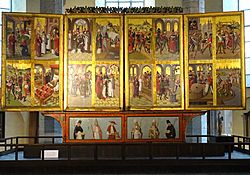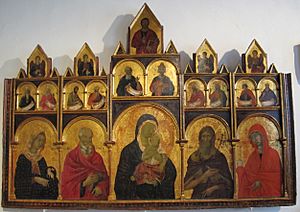Polyptych facts for kids
A polyptych (say it: POL-ip-tik) is a special kind of painting. The word comes from Greek and means "many folds." Imagine a painting that is split into several parts or panels. That's a polyptych!
Sometimes, these artworks have specific names based on how many parts they have:
- A diptych has two parts.
- A triptych has three parts.
- A tetraptych or quadriptych has four parts.
- A polyptych is the general name for any artwork with more than one part.
Usually, a polyptych has one main panel that is the biggest. The other panels are called "side" panels or "wings." These hinged panels can sometimes be moved to show different scenes. The top panels often show calm scenes. The bottom part, called the predella, often shows smaller story scenes.
Polyptychs were very popular with early Renaissance painters. Most of these artists designed their works to be altarpieces. These were special artworks placed behind the altar in churches and cathedrals. This art style was also liked by Japanese ukiyo-e printmakers during the Edo period.
Some old books from the Middle Ages are also called polyptychs. This is especially true for Carolingian works. In these books, the columns of text on the page have borders that look like the frames of polyptych paintings.
The History of Polyptychs
Polyptychs started as a form of sacred art, meaning art for religious purposes. But today, the word "polyptych" can describe any artwork made of many pieces. This includes sculptures, photos, videos, or even art made with text.
In European Renaissance painting, polyptychs were often used in churches. They were usually altarpieces for people to pray to. We don't know exactly when polyptychs first appeared. However, the earliest ones seem to come from Italy in the early 1300s.
Church art changed a lot in the 1200s. It mixed the Byzantine style of iconostasis (a screen with icons) with the Gothic building style. These two influences helped create the Renaissance polyptychs we know today. The artist Duccio di Buoninsegna, who worked in Siena in the early 1300s, made some early polyptychs. His work shows strong Byzantine influences.
Famous Polyptych Artworks
Many famous artworks are polyptychs. Here are some examples:
- The Stefaneschi Polyptych, made around 1320 by Giotto.
- The Ghent Altarpiece, finished in 1432 by Hubert van Eyck and Jan van Eyck.
- The Last Judgement (Lochner) from 1435 by Stefan Lochner.
- Polyptych of the Misericordia (1445–1462) by Piero della Francesca.
- The Beaune Altarpiece (1450) by Rogier van der Weyden.
- Saint Augustine Polyptych (1470) by Perugino.
- The Saint Vincent Panels (1470–1480) by Nuno Gonçalves.
- The Monte San Martino Altarpiece (around 1471) by Carlo Crivelli.
- St. Dominic Polyptych (1506–1508) by Lorenzo Lotto.
- The Isenheim Altarpiece (1512–1516) by Matthias Grünewald.
- Poema de Córdoba (1913-1915) by Julio Romero de Torres.
- A "quad-tych" created by the fictional artist Sander Cohen in the 2007 video game Bioshock.
See also
- Polyptych (document)



